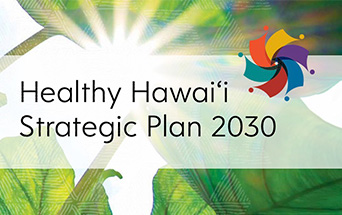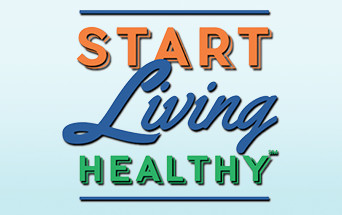Early Childhood Care & Education
More than 60% of Hawaii’s young children under the age of 6 have both parents in the workforce, meaning that a majority of Hawaii’s children spend a large amount of time in care outside of their home. Thus no other setting outside of the home rivals the reach early childhood care and education (ECE) settings have for young children with respect to food and drink intake and opportunities for, and encouragement of, physical activity, screen time limitations, and the development of healthy habits.
Childhood obesity is a national epidemic that disproportionately burdens low income and ethnic minority communities. By preschool, nearly one-third of low income children are already overweight or obese, setting the stage for a myriad of adverse health conditions in adolescence and adulthood. As a Healthy Kids, Healthy Future State, the Department of Health, guided by the CDC’s Spectrum of Opportunities Framework for State-Level Obesity Prevention Efforts Targeting the Early Care and Education Settings, partners with national organizations, state agencies, county and community partners, and ECE programs and administrators to embed physical activity and nutrition best practices (including screen time and breastfeeding) into Hawaii’s ECE system and settings.
The Spectrum of Opportunities Framework
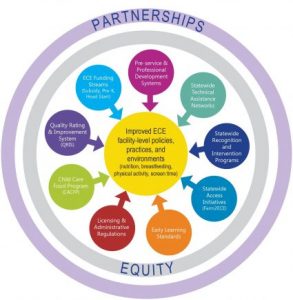 The Spectrum of Opportunities Framework outlines how both standards and support for ECE providers to achieve these physical activity and nutrition standards can be embedded into a state’s ECE system. The focus is on system-level changes, as these have the potential for statewide impact by reaching either all legally-operating providers or a subset(s) of providers statewide who are specifically served by an opportunity area (e.g. all licensed providers; all providers accepting subsidy funds; all providers required to complete pre-service/professional development training).
The Spectrum of Opportunities Framework outlines how both standards and support for ECE providers to achieve these physical activity and nutrition standards can be embedded into a state’s ECE system. The focus is on system-level changes, as these have the potential for statewide impact by reaching either all legally-operating providers or a subset(s) of providers statewide who are specifically served by an opportunity area (e.g. all licensed providers; all providers accepting subsidy funds; all providers required to complete pre-service/professional development training).
Successful state efforts require strong partnerships among stakeholders from both the state’s early childhood and public health arenas, as well as careful consideration of factors that impact the viability of any opportunity at a given point in time. Such factors include, but are not limited to: costs (resource, personnel), stakeholder support and political will, available resources, reach, timing, and ECE provider needs. A state’s equity goals for ECE and public health should both be considered for all efforts, not just those focused on the opportunities that target providers serving low-income children (e.g. the Child and Adult Care Food Program, child care subsidy, Head Start). Not all opportunities, nor sub-options, need to be pursued successfully to achieve impact. However, it is likely that multiple opportunities pursued as part of a coordinated approach that takes advantage of their interconnectedness will be most effective.
*New* Go NAPSACC – Now available in Hawaii!
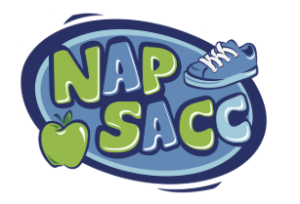 The Go Nutrition and Physical Activity Self-Assessment for Child Care (NAPSACC) is an innovative online tool designed to assist early care and education programs in promoting healthy eating and physical activity among children. Participating providers will gain free access to the platform, which includes self-assessments, goal-setting resources, and a comprehensive library of training materials, activities, and handouts. These resources are aimed at helping programs achieve higher quality standards, enhancing physical play, and improving nutrition for children. There are 7 topics within Go NAPSACC: Child Nutrition, Breast Feeding Infant Feeding, Farm to ECE, Oral Health, Infant & Child Physical Activity, Outdoor Play & Learning, and Screen Time. These 7 topics align with the Department of Health’s Wellness Guidelines for Nutrition and Physical Activity In Hawaii’s Early Childhood Care and Education Settings.
The Go Nutrition and Physical Activity Self-Assessment for Child Care (NAPSACC) is an innovative online tool designed to assist early care and education programs in promoting healthy eating and physical activity among children. Participating providers will gain free access to the platform, which includes self-assessments, goal-setting resources, and a comprehensive library of training materials, activities, and handouts. These resources are aimed at helping programs achieve higher quality standards, enhancing physical play, and improving nutrition for children. There are 7 topics within Go NAPSACC: Child Nutrition, Breast Feeding Infant Feeding, Farm to ECE, Oral Health, Infant & Child Physical Activity, Outdoor Play & Learning, and Screen Time. These 7 topics align with the Department of Health’s Wellness Guidelines for Nutrition and Physical Activity In Hawaii’s Early Childhood Care and Education Settings.
Start your journey with Go NAPSACC here!
*New* Ono for Hawai’i Map– Farm to Early Childcare Education
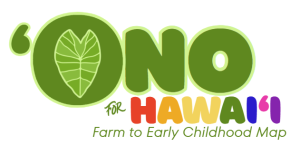 The Ono for Hawai’i Map is a resource designed to foster healthier Early Childcare sites through a Farm-to-Early Childcare Education initiative. This map supports hands-on learning opportunities and promotes local purchasing by highlighting ECE-friendly locations such as farms, farmers’ markets, and food hubs.
The Ono for Hawai’i Map is a resource designed to foster healthier Early Childcare sites through a Farm-to-Early Childcare Education initiative. This map supports hands-on learning opportunities and promotes local purchasing by highlighting ECE-friendly locations such as farms, farmers’ markets, and food hubs.
Integrating locally grown produce into children’s meals and snacks, along with engaging them in hands-on experiences such as gardening and visits to traditional lo’i (kalo patches), is crucial for early childhood development. These practices not only promote cultural appreciation but also enhance overall health and wellness. By involving children in these activities, we spark their curiosity, strengthen their connection to ‘āina (land), and instill an ono (likeness) for local produce, supporting their cognitive and emotional development. Gardening, in particular, aids in the development of fine motor skills, fosters social interactions, and encourages teamwork, all of which help cultivate a sense of community and belonging among children.
View the Ono for Hawaii Map Here
Aloha Farmers! Please fill out the Farm Information Form to add or edit your information on the Ono for Hawaii Map.
Data Vintage
Data on licensed ECE providers are current as of March 2025, other ECE provider capacity and USDA food program participation are for school year 2024-2025, and farm/food provider data are from 2024-2025. These maps do not reflect possible subsequent changes.
Data Sources
Early Care and Education Providers: ECE providers’ location, program/license type, capacity, and USDA food program participation courtesy of People Attentive to Children (PATCH); the State of Hawaiʻi Department of Human Services, Benefit, Employment and Support Services Division, Child Care Program; the Executive Office on Early Learning, the State of Hawaiʻi Public Charter School Commission; and the Hawaiʻi Child Nutrition Programs.
Farmers Markets, Food Hubs and ECE Friendly Farms/Gardens: Data for farmers markets, food hubs and farms was collected via online sources 2024-2025.
We want to express our deepest gratitude to The University of Hawaiʻi Center on the Family, Early Childhood Action Strategy (ECAS), People Attentive To Children (PATCH), Hawaiʻi Child Nutrition Programs, JNS Consulting, The University of Hawaiʻi Healthy Hawaiʻi Evaluation Team, Hawaiʻi Children’s Environmental Health Initiative (CEHI) at the University of Illinois Chicago, Department of Pediatrics, and all the ECE-friendly farms and gardens, food hub organizations, and farmers markets that have come together to support feeding our keiki local across the state. Your participation in this project is invaluable.
If you would like to update any information on this map, please email [email protected]
Wellness Guidelines for Nutrition and Physical Activity in Hawai‘i’s Early Childhood Care and Education Settings
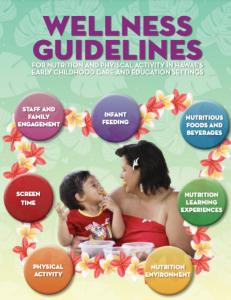 The need for stronger efforts to support physical activity and nutrition with young children has become increasingly urgent. Childhood obesity is now a global epidemic and almost one in three kindergartners in Hawaii are considered overweight or obese. Children with obesity are at higher risk for having other health problems such as asthma, sleep apnea, bone and joint problems, and type 2 diabetes.
The need for stronger efforts to support physical activity and nutrition with young children has become increasingly urgent. Childhood obesity is now a global epidemic and almost one in three kindergartners in Hawaii are considered overweight or obese. Children with obesity are at higher risk for having other health problems such as asthma, sleep apnea, bone and joint problems, and type 2 diabetes.
ECE providers play an integral role in helping children learn skills that support lifelong healthy behaviors and directly influence what they eat, how active they are, and how much screen time they consume. ECE providers also serve as resources for families who are breastfeeding their little ones, looking for ways to introduce new foods, trying to be more active, and building a foundation for their child’s success in life.
The Wellness Guidelines provide opportunities to incorporate nutrition and physical activity into daily routines and learning experiences. Each wellness guideline summarizes the overall strategy to enhance health and includes a detailed list of best practices. In addition to addressing concerns around obesity, the purpose of the Wellness Guidelines is to promote quality care environments and interactions between ECE providers, children, and families. We hope that ECE providers and administrators will find these materials useful when developing their own plans and policies to support the health and wellness of young children within their program(s).
The foundation for the Wellness Guidelines is Caring for Our Children: National Health and Safety Performance Standards Guidelines for Early Care and Education Programs. The Wellness Guidelines has also been thoroughly vetted with local and national content experts. Additional resources were cross-walked and referenced, including but not limited to: Head Start Program Performance Standards, Child and Adult Care Food Program, Hawaii Administrative Rules, National Association for the Education of Young Children Accreditation Standards, and Nemours Child Care Wellness Policy Workbook.
View the Hawaii ECE Wellness Guidelines here.
Farm to Early Childhood Education
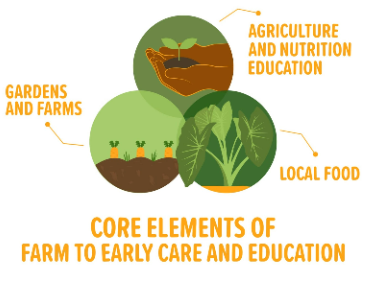 Farm to Early Childhood Education (farm to ECE) is a policy, systems, and environment (PSE) change intervention designed to increase access to healthy, local foods in ECE settings through local food purchasing and gardening; increase the quality of the ECE setting through food, nutrition, and agriculture related experiential education; increase children’s acceptance and preference for healthy foods; increase children and family knowledge about healthy foods and local food systems; and positively influence child, family, and provider health behaviors.
Farm to Early Childhood Education (farm to ECE) is a policy, systems, and environment (PSE) change intervention designed to increase access to healthy, local foods in ECE settings through local food purchasing and gardening; increase the quality of the ECE setting through food, nutrition, and agriculture related experiential education; increase children’s acceptance and preference for healthy foods; increase children and family knowledge about healthy foods and local food systems; and positively influence child, family, and provider health behaviors.
Farm to ECE involves implementing one or more of three key elements: 1) procurement of local food, 2) education with activities related to agriculture and foods, and 3) contact with growing food, such as through community or on-site/pre-school gardens and/or local farm visits. As farm to ECE is not a “one size fits all” strategy, the core elements adapt readily to different settings, geographic locations, enrollment numbers, and diverse ages and abilities of children. Farm to ECE aims to advance racial and social equity by increasing access to healthy, local foods and high quality education opportunities for all children.
View the Hawaii Farm to ECE Coalition website here.
ECE Licensing Scorecard
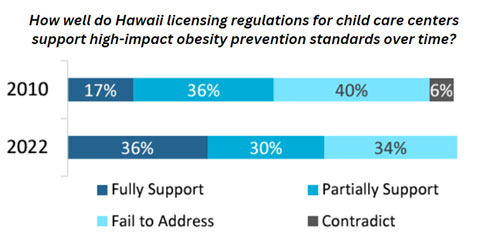
The CDC’s State Licensing Scorecards offer one way for public health practitioners, ECE advocates, and parents to understand how well their state’s child care licensing regulations support science-based, healthy eating and physical activity standards.
Licensing regulations for ECE programs can encourage widespread adoption of policies and practices that support healthy eating and physical activity. This scorecard measures state support of 47 high-impact obesity prevention standards across four ECE licensing subdomains: 1) healthy infant feeding, 2) nutrition, 3) physical activity, and 4) screen time limits. It can be used to understand how Hawaii compares nationally and to other states.


